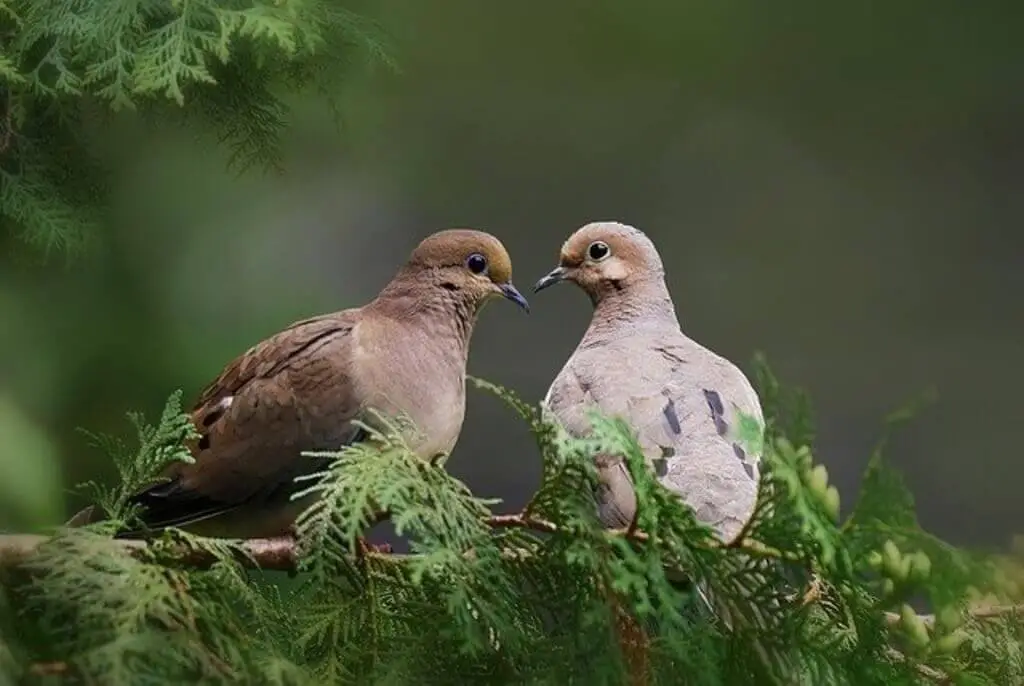Ever wonder why mourning doves are among the most beloved birds in North America? These graceful creatures hold more secrets than you might think. Their soft coos, subtle beauty, and fascinating behaviors have captured the hearts of birders and backyard watchers alike. In this guide, explore 25 fascinating facts about mourning doves that will deepen your appreciation for these gentle birds.
Click the Play button below to listen to our podcast:
Table of Contents
- 1 What Are Mourning Doves?
- 2 Range and Habitat
- 3 Behavior and Adaptations
- 4 Diet and Feeding Habits
- 5 Reproduction and Family Life
- 6 Social Life and Survival
- 7 Adaptations to the Environment
- 8 Cultural and Symbolic Significance
- 9 Fun and Lesser-Known Facts
- 10 Mourning Dove vs. Similar Species
- 11 Conclusion
- 12 Author
What Are Mourning Doves?
The Basics: Scientific Name and Appearance
- Scientific Name: Zenaida macroura. This name is derived from the Greek word for “long tail,” which perfectly describes their most distinguishing feature. Mourning doves are medium-sized birds with slender bodies that appear delicate yet robust.
- Physical Features: Their feathers are a soft blend of earthy browns and gentle grays, giving them excellent camouflage in their natural habitats. The wings are marked with distinct black spots, and their long, pointed tails are edged with white. A subtle iridescent sheen can sometimes be seen on their necks in the right light.
- Size: Measuring about 12 inches from beak to tail, with an impressive wingspan reaching up to 18 inches, mourning doves are the perfect balance of elegance and agility. Their light build allows them to take flight swiftly and maneuver easily through a variety of landscapes.
Range and Habitat
Where Do Mourning Doves Live?
- Widespread Distribution: Mourning doves have one of the broadest ranges of any North American bird. They can be found from the southern reaches of Canada all the way down through Mexico and into Central America, adapting to a wide variety of environments.
- Urban Adaptation: These birds have shown remarkable adaptability, thriving not only in rural fields and woodlands, but also in suburban neighborhoods and bustling cities. They’re frequently seen perched on telephone wires, rooftops, and backyard fences, making them a familiar sight to many people.
- Preferred Habitats: Mourning doves favor open or semi-open landscapes, such as grasslands, farmlands, and lightly wooded areas. They avoid dense forests and deserts, but are otherwise highly versatile, able to make a home wherever food and nesting sites are available.
Distribution Maps (Source)
Behavior and Adaptations
Unique Flight and Sounds
- Whistling Wings: When a mourning dove takes off in a hurry, its wings produce a sharp, whistling noise that can startle both predators and other birds. This sound is created by the air rushing through specially shaped feathers, acting as an audible warning signal.
- Speed: These birds are capable of flying at remarkable speeds, sometimes reaching up to 55 miles per hour. Their pointed wings and long tails help them accelerate quickly and make sharp turns, aiding in both escape from danger and long migratory journeys.
- Soothing Call: The soft, mournful cooing of the mourning dove is one of the most recognizable bird calls in North America. This gentle sound is often associated with tranquility and is commonly heard in the early morning or late afternoon, adding a peaceful ambiance to outdoor spaces.
Diet and Feeding Habits
Seed Specialists
- Diet: Mourning doves are primarily granivores, which means their diet consists almost entirely of seeds. They consume a diverse array of seeds from wild grasses, weeds, cultivated grains, and sometimes even garden flowers. Unlike many other birds, they rarely eat insects or fruit.
- Feeding Technique: These birds prefer to feed on the ground, where they walk with a gentle, bobbing motion as they search for seeds. They can consume up to 20% of their body weight in seeds each day, making them efficient foragers.
- Crop Storage: Mourning doves have a specialized pouch in their throat called a crop, which allows them to quickly gather and temporarily store large quantities of seeds. This adaptation enables them to feed rapidly in exposed areas before retreating to safety to digest their meal in peace.
Reproduction and Family Life
Breeding and Parenting
- Monogamous Pairs: Mourning doves typically form strong, monogamous bonds with a single mate, often staying together for life. Their courtship displays involve gentle preening, bowing, and soft coos, strengthening their pair bond.
- Nesting: The female usually lays two small, white eggs per clutch, which she places in a simple nest constructed from twigs and grass. The nest is often built in trees, shrubs, or even on man-made structures like window ledges and hanging planters.
- Incubation: Both parents share the responsibility of incubating the eggs, taking turns to ensure the eggs remain warm and protected. The incubation period lasts about two weeks, after which the chicks, known as squabs, hatch blind and helpless.
- Crop Milk: For the first several days of life, squabs are fed a nutritious substance called “crop milk,” which is secreted by both parents. This rich, milk-like fluid is essential for the rapid growth and development of the chicks, providing proteins and fats not found in seeds.
- Rapid Growth: Mourning dove chicks grow at an astonishing rate, doubling in size within a few days. By the second week, they begin to eat regurgitated seeds and are usually ready to leave the nest just two weeks after hatching, though parents may continue feeding them for a short time afterward.
Social Life and Survival
Interactions and Longevity
- Feeder Behavior: At backyard feeders, mourning doves are generally peaceful and non-confrontational, often yielding to more aggressive species. Their calm demeanor makes them a welcome presence among mixed flocks of songbirds.
- Sleeping Habits: Unlike many birds that tuck their heads under their wings to sleep, mourning doves rest with their heads nestled between their shoulders. This unique posture helps them remain alert to potential threats even while dozing.
- Lifespan: In the wild, mourning doves typically live around 1.5 to 3 years, though they can survive up to 5 years if conditions are favorable. In captivity, some have lived more than 20 years, but such longevity is rare in the wild due to constant environmental threats.
- Mortality Rates: Mourning doves face significant challenges in the wild, including predation by hawks, cats, and snakes, as well as harsh weather conditions. As a result, only about half of adult doves and a quarter of young doves survive their first year.
- Population: Despite these hazards, mourning doves remain one of the most abundant bird species in North America. Their high reproductive rate and adaptability help maintain a stable population, even though they are heavily hunted in some regions.
Adaptations to the Environment
Coping with Heat and Rain
- Panting: To regulate their body temperature during hot weather, mourning doves pant by rapidly opening and closing their beaks, much like a dog. This behavior helps dissipate excess heat and keep them cool.
- Water Needs: Because panting causes them to lose moisture, mourning doves must drink frequently, often visiting water sources several times a day. They are unique among birds in their ability to drink by sucking up water continuously without tilting their heads back.
- Rain Adaptation: When it rains, mourning doves flatten their bodies and spread their wings slightly to allow water to run off their feathers. This helps them stay dry and maintain their ability to fly even during wet weather.
Cultural and Symbolic Significance
Meaning and Symbolism
- Symbols of Hope: Across many cultures and throughout history, mourning doves have been seen as symbols of peace, renewal, and hope. Their gentle appearance and soothing calls evoke feelings of comfort and reassurance.
- Spiritual Connections: In some traditions, the presence of a mourning dove is believed to be a message from loved ones who have passed away, offering guidance or comfort during difficult times.
- Art and Literature: Mourning doves frequently appear in poetry, paintings, and music, where they are often associated with themes of love, loss, and the cycles of life.
Fun and Lesser-Known Facts
Extraordinary Abilities and Traits
- Nicknames: Mourning doves are also known as rain doves, turtle doves, chueybird, and Carolina doves, reflecting their widespread presence and the affection people have for them.
- Distinctive Silhouette: Their slender necks, small heads, plump bodies, and long, pointed tails give them a unique outline that is easy to recognize, even from a distance or in low light.
- Blue Eye Rings: Adult mourning doves have a delicate blue ring of bare skin encircling their eyes, adding a touch of color to their otherwise muted appearance.
- Neck Illusion: When at rest, their necks often seem to disappear into their bodies, but when alert or stretching, their necks become surprisingly long and graceful.
Mourning Dove vs. Similar Species
| Feature | Mourning Dove | Eurasian Collared-Dove | White-winged Dove |
|---|---|---|---|
| Tail Shape | Long, pointed, white-tipped | Square, black-banded | Broad, with white stripe |
| Neck Markings | None | Black collar band | None |
| Wing Markings | Black spots | Minimal | Bold white stripe |
| Size | Medium, slender | Slightly larger, stockier | Similar size, bulkier |
| Call | Soft, mournful coo | Louder, two-syllable coo | Harsh, nasal call |
Conclusion
Mourning doves are much more than just a familiar sight in our neighborhoods and parks. Their fascinating biology, gentle behaviors, and rich symbolism make them a truly extraordinary species. Whether you’re a lifelong birdwatcher or simply someone who enjoys the occasional glimpse of wildlife, these 25 expanded facts will help you see mourning doves in a new and appreciative light. Their resilience, adaptability, and quiet beauty ensure that they will continue to be cherished for generations to come.





